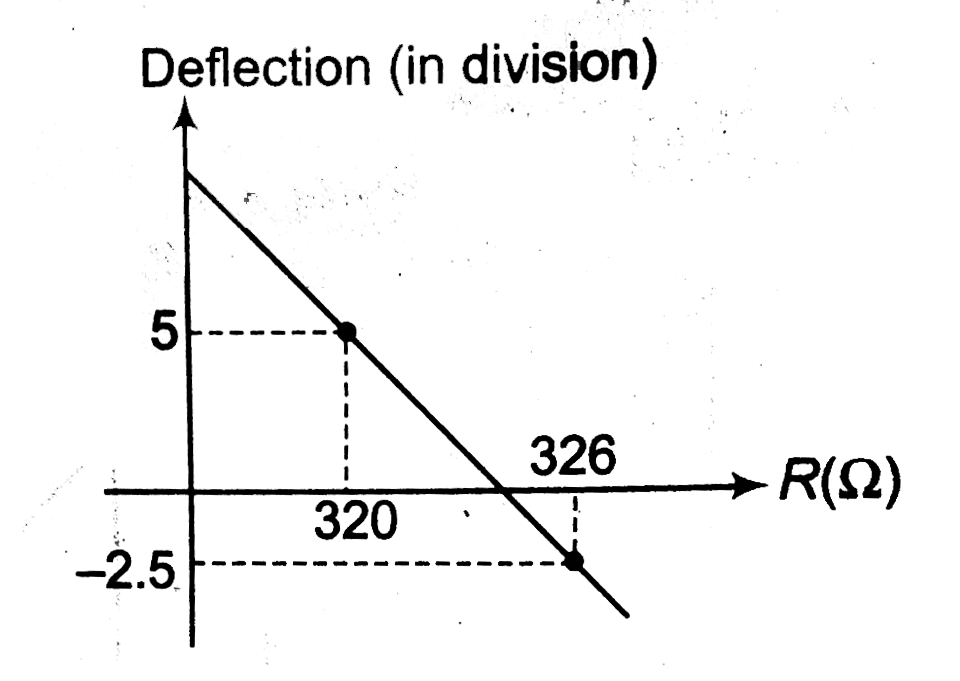In post office box experiment QP=110. In R if 142 Ω is used then we get deflection towards right and if R=143Ω, then deflection is towards left. What is the range of unknown resistance?
The correct Answer is:A, B, C, D
To solve the problem, we will follow these steps:
Step 1: Understand the relationship between Q, P, and R
In the post office box experiment, we are given that QP=110. This implies that PQ=10.
Step 2: Apply the formula from the experiment
According to the post office box experiment, we have the relationship:
PQ=RX
where R is the known resistance and X is the unknown resistance.
Step 3: Substitute the value of P/Q
From Step 1, we substitute PQ=10 into the equation:
10=RX
Step 4: Rearrange the equation to find X
Rearranging the equation gives us:
X=R10
Step 5: Calculate X for R=142Ω
Substituting R=142Ω into the equation:
X=14210=14.2Ω
Step 6: Calculate X for R=143Ω
Now substituting R=143Ω:
X=14310=14.3Ω
Step 7: Determine the range of unknown resistance X
From the calculations in Steps 5 and 6, we find that the unknown resistance X ranges from:
14.2Ω to 14.3Ω
Final Answer
The range of the unknown resistance X is:
14.2Ω≤X≤14.3Ω
---
In the post office box experiment, we are given that QP=110. This implies that PQ=10.
According to the post office box experiment, we have the relationship:
PQ=RX
where R is the known resistance and X is the unknown resistance.
From Step 1, we substitute PQ=10 into the equation:
10=RX
Rearranging the equation gives us:
X=R10
Substituting R=142Ω into the equation:
X=14210=14.2Ω
Now substituting R=143Ω:
X=14310=14.3Ω
From the calculations in Steps 5 and 6, we find that the unknown resistance X ranges from:
14.2Ω to 14.3Ω
The range of the unknown resistance X is:
14.2Ω≤X≤14.3Ω
Topper's Solved these Questions
- CURRENT ELECTRICITYBook:DC PANDEY ENGLISHChapter:CURRENT ELECTRICITYExercise:Exercise 23.13
Explore 2 Videos
- CURRENT ELECTRICITYBook:DC PANDEY ENGLISHChapter:CURRENT ELECTRICITYExercise:Level 1 Assertion And Reason
Explore 11 Videos
- CURRENT ELECTRICITYBook:DC PANDEY ENGLISHChapter:CURRENT ELECTRICITYExercise:Exercise 23.11
Explore 3 Videos
- COMMUNICATION SYSTEMBook:DC PANDEY ENGLISHChapter:COMMUNICATION SYSTEMExercise:Subjective
Explore 11 Videos
- ELECTROMAGNETIC INDUCTIONBook:DC PANDEY ENGLISHChapter:ELECTROMAGNETIC INDUCTIONExercise:Medical entrances gallery
Explore 25 Videos
Similar Questions
In post office box experiment, if QP=110. In (R ) if 142Ω is used then we get deflection towards right and if R=143Ω , then deflection is towards left. What is the range of unknown resistance?
View SolutionIn a certain experiment if QP=110 in R if 192Ω if used we are getting deflection toward right at 193Ω again toward rightr but at 194Ω deflection is toward left the unknown resistance should lie between .
View SolutionA galvanometer having 50 divisions provided with a variable shunt S is used to measure the current when connected in series with a resistance of 90Ω and a battery of internal resistance 10Ω. It is observed that when the shunt resistances are 10Oemga and 50Ω, the deflections are, respectively, 9 and 30 divisions. What is the resistance of the galvanometer
View SolutionA galvanometer vaving 50 divisions provided with a variable shunt S is used to measure the current when conneted in series with a resistance of 90Ω and a battery of internal resistance 10Ω. It is observed that when the snt resistaces are 10Ω&70Ω respectively, the deflection are respectively 9 and 30 dividions. What is the resistance of the galvanometer ? Further, if the full scale deflection of the galvanometer movement require 200 mA. find the emf of the cell.
View Solution
A galvanometer has a 50 division scale. Bat- tery has no internal resistance. It is found that there is deflection of 40 divisions when R=2400Ω . Deflection becomes 20 divisions when resistance taken from resistance box is 4900Ω. Then we can conclude :
View Solution
A galvanometer has a 50 division scale. Bat- tery has no internal resistance. It is found that there is deflection of 40 divisions when R=2400Ω . Deflection becomes 20 divisions when resistance taken from resistance box is 4900Ω. Then we can conclude :
View SolutionIn an experiment with a post office box, the radio of arms are 1000:10. If the value of the third resistance is 999Ω, find the unknows resistance.
View SolutionFor a post office box, the graph of galvanometer deflection verus (R ) (resistance pulled out of resistance box) for the ratio 100.1 is given as shown. Find the value of unknown resistance.
 .
.
View SolutionAn electron is projectd horizontally with a kinetic energy of 10 keV. A magnetic feld of strength 1.0X10−7 T exists in the vertically upward direction. (a)will the electron deflect towards right or towards left of its motion? (b) calculate the sideways deflection of the electrion in travelling through 1m. make appropriate approximations.
View SolutionAs shown in the figure initially switch k1 is open and k2 is closed and deflection of galvanometer is x. Now both switch are closed then the deflection in galvanometer is x/5 (given RH=5Ω). The resistance of galvanometer is

View Solution
